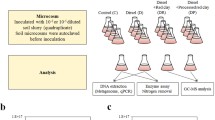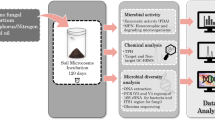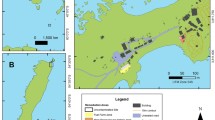Abstract
To improve the coupling of in situ chemical oxidation and in situ bioremediation, a systematic analysis was performed of the effect of chemical oxidation with Fenton's reagent, modified Fenton's reagent, permanganate, or persulfate, on microbial diversity and activity during 8 weeks of incubation in two diesel-contaminated soils (peat and fill). Chemical oxidant and soil type affected the microbial community diversity and biodegradation activity; however, this was only observed following treatment with Fenton's reagent and modified Fenton's reagent, and in the biotic control without oxidation. Differences in the highest overall removal efficiencies of 69 % for peat (biotic control) and 59 % for fill (Fenton's reagent) were partially explained by changes in contaminant soil properties upon oxidation. Molecular analysis of 16S rRNA and alkane monooxygenase (alkB) gene abundances indicated that oxidation with Fenton's reagent and modified Fenton's reagent negatively affected microbial abundance. However, regeneration occurred, and final relative alkB abundances were 1–2 orders of magnitude higher in chemically treated microcosms than in the biotic control. 16S rRNA gene fragment fingerprinting with DGGE and prominent band sequencing illuminated microbial community composition and diversity differences between treatments and identified a variety of phylotypes within Alpha-, Beta-, and Gammaproteobacteria. Understanding microbial community dynamics during coupled chemical oxidation and bioremediation is integral to improved biphasic field application.




Similar content being viewed by others
References
Baek KH, Voon BD, Cho DH, Kim BH, Oh HM, Kim HS (2009) Monitoring bacterial population dynamics using real-time PCR during the bioremediation of crude-oil-contaminated soil. J Microbiol Biotechnol 19(4):339–345. doi:10.4014/jmb.0807.423
Buyuksonmez F, Hess T, Crawford R, Paszczynski A, Watts R (1999) Optimization of simultaneous chemical and biological mineralization of perchloroethylene. Appl Environ Microbiol 65(6):2784
Chapelle FH, Bradley PM, Casey CC (2005) Behavior of a chlorinated ethene plume following source-area treatment with Fenton's reagent. Ground Water Monit Remediat 25(2):131–141. doi:10.1111/j.1745-6592.2005.0020.x
Crimi ML, Siegrist RL (2003) Geochemical effects on metals following permanganate oxidation of DNAPLs. Ground Water 41(4):458–469
Cuypers C, Pancras T, Grotenhuis T, Rulkens W (2002) The estimation of PAH-bioavailability in contaminated sediments using hydroxypropyl-b-cyclodextrin and Triton X-100 extraction techniques. Chemosphere 45:1235–1245
Do SH, Jo JH, Jo YH, Lee HK, Kong SH (2009) Application of a peroxymonosulfate/cobalt (PMS/Co(II)) system to treat diesel-contaminated soil. Chemosphere 77(8):1127–1131. doi:10.1016/j.chemosphere.2009.08.061
dos Santos HF, Cury JC, do Carmo FL, dos Santos AL, Tiedje J, van Elsas JD, Rosado AS, Peixoto RS (2011) Mangrove bacterial diversity and the impact of oil contamination revealed by pyrosequencing: bacterial proxies for oil pollution. PLoS One 6(3)
Eichner CA, Erb RW, Timmis KN, Wagner-Dobler I (1999) Thermal gradient gel electrophoresis analysis of bioprotection from pollutant shocks in the activated sludge microbial community. Appl Environ Microbiol 65(1):102–109
Fierer N, Bradford MA, Jackson RB (2007) Toward an ecological classification of soil bacteria. Ecology 88(6):1354–1364
Gates DD, Siegrist RL (1995) In-situ oxidation of trichloroethylene using hydrogen-peroxide. J Environ Eng-ASCE 121(9):639–644. doi:10.1061/(ASCE)0733-9372(1995)121:9(639)
Greer CW, Whyte LG, Niederberger TD (2010) Microbial communities in hydrocarbon-contminated temperate, tropical, alpine, and polar soils. In: Timmis KN (ed) Handbook of hydrocarbon and lipid microbiology. Springer, Berlin, pp 2313–2328
Heiss-Blanquet S, Rochette S, Monot F (2004) Evaluation of alkane biodegradation potential of environmental samples by competitive PCR. Paper presented at the European Symposium on Environmental Biotechnology, Eseb 2004
Hrapovic L, Sleep BE, Major DJ, Hood ED (2005) Laboratory study of treatment of trichloroethene by chemical oxidation followed by bioremediation. Environ Sci Technol 39(8):2888–2897. doi:10.1021/es049017y
ITRC (2005) Technical and regulatory guidance for in situ chemical oxidation of contaminated soil and groundwater ISCO-2. 2 edn. Interstate Technology and Regulatory Council, In Situ Chemical Oxidation Team, Washington, DC
Jeffrey AM, Yeh HJC, Jerina DM, Patel TR, Davey JF, Gibson DT (1975) Initial reactions in oxidation of naphthalene by Pseudomonas putida. Biochemistry 14(3):575–584. doi:10.1021/bi00674a018
Jung H, Choi H (2003) Effects of in situ ozonation on structural change of soil organic matter. Environ Eng Sci 20(4):289–299
Jung H, Ahn Y, Choi H, Kim IS (2005) Effects of in-situ ozonation on indigenous microorganisms in diesel contaminated soil: survival and regrowth. Chemosphere 61(7):923–932. doi:10.1016/j.chemoshere.2005.03.038
Kasai Y, Takahata Y, Hoaki T, Watanabe K (2005) Physiological and molecular characterization of a microbial community established in unsaturated, petroleum-contaminated soil. Environ Microbiol 7(6):806–818. doi:10.1111/j.1462-2920.2005.00754.x
Kim I, Lee M (2012) Pilot scale feasibility study for in-situ chemical oxidation using H2O2 solution conjugated with biodegradation to remediate a diesel contaminated site. J Hazard Mater 241:173–181. doi:10.1016/j.jhazmat2012.09.022
Kloos K, Munch JC, Schloter M (2006) A new method for the detection of alkane-monooxygenase homologous genes (alkB) in soils based on PCR-hybridization. J Microbiol Methods 66(3):486–496. doi:10.1016/j.mimet.2006.01.014
Kuhad RC, Gupta R (2009) Biological remediation of petroleum contaminants. In: Singh A, Ward OP (eds) Advances in applied bioremediation, Soil biology. Springer, Berlin, pp 173–187
Kulik N, Goi A, Trapido M, Tuhkanen T (2006) Degradation of polycyclic aromatic hydrocarbons by combined chemical pre-oxidation and bioremediation in creosote contaminated soil. J Environ Manage 78(4):382–391. doi:10.1016/j.jenvman.2005.05.005
Lee BT, Kim KW (2002) Ozonation of diesel fuel in unsaturated porous media. Appl Geochem 17(8):1165–1170. doi:10.1016/S0883-2927(02)00011-2
Liang YT, Van Nostrand JD, Wang J, Zhang X, Zhou JZ, Li GH (2009) Microarray-based functional gene analysis of soil microbial communities during ozonation and biodegradation of crude oil. Chemosphere 75(2):193–199. doi:10.1016/j.chemosphere.2008.12.007
Ludwig W, Strunk O, Westram R, Richter L, Meier H, Yadhukumar BA, Lai T, Steppi S, Jobb G, Forster W, Brettske I, Gerber S, Ginhart AW, Gross O, Grumann S, Hermann S, Jost R, Konig A, Liss T, Lussmann R, May M, Nonhoff B, Reichel B, Strehlow R, Stamatakis A, Stuckmann N, Vilbig A, Lenke M, Ludwig T, Bode A, Schleifer KH (2004) ARB: a software environment for sequence data. Nucleic Acids Res 32(4):1363–1371. doi:10.1093/nar/gkh293
Maphosa F, de Vos WM, Smidt H (2010) Exploiting the ecogenomics toolbox for environmental diagnostics of organohalide-respiring bacteria. Trends Biotechnol 28(6):308–316. doi:10.1016/j.tibtech.2010.03.005
Marques AV, dos Santos SCC, Casella RD, Vital RL, Sebastin GV, Seldin L (2008) Bioremediation potential of a tropical soil contaminated with a mixture of crude oil and production water. J Microbiol Biotechnol 18(12):1966–1974. doi:10.4014/jmb.0800.279
Miller CM, Valentine RL, Roehl ME, Alvarez PJJ (1996) Chemical and microbiological assessment of pendimethalin-contaminated soil after treatment with Fenton's reagent. Water Res 30(11):2579–2586. doi:10.1016/S0043-1354(96)00151-0
Mills D, Fitzgerald K, Litchfield C, Gillevet P (2003) A comparison of DNA profiling techniques for monitoring nutrient impact on microbial community composition during bioremediation of petroleum-contaminated soils. J Microbiol Meth 54(1):57–74
Morgan P, Watkinson RJ (1994) Biodegradation of components of petroleum. In: Ratledge C (ed) Biochemistry of microbial degradation. Kluwer Academic Publishers, Dordrecht, pp 1–31
Muyzer G, Dewaal EC, Uitterlinden AG (1993) Profiling of complex microbial populations by denaturing gradient gel electrophoresis analysis of polymerase chain reaction-amplified genes-coding for 16S ribosomal RNA. Appl Environ Microbiol 59(3):695–700
Nam K, Rodriguez W, Kukor JJ (2001) Enhanced degradation of polycyclic aromatic hydrocarbons by biodegradation combined with a modified Fenton reaction. Chemosphere 45(1):11–20. doi:10.1016/S0045-6535(01)00051-0
Ndjou'ou AC, Bou-Nasr J, Cassidy D (2006) Effect of Fenton reagent dose on coexisting chemical and microbial oxidation in soil. Environ Sci Technol 40(8):2778–2783. doi:10.1021/es0525152
NEN5733 (1997) Soil-determination of mineral oil content in soil and sediments with gas chromatography. Nederlands Normalisatie Instituut, Delft
Nubel U, Engelen B, Felske A, Snaidr J, Wieshuber A, Amann RI, Ludwig W, Backhaus H (1996) Sequence heterogeneities of genes encoding 16S rRNAs in Paenibacillus polymyxa detected by temperature gradient gel electrophoresis. J Bacteriol 178(19):5636–5643
Pan LW, Siegrist RL, Crimi M (2012) Effects of in situ remediation using oxidants or surfactants on subsurface organic matter and sorption of trichloroethene. Ground Water Monit Remediat 32:96–105
Pansu M, Gautheyrou J (2006) Handbook of soil analysis : mineralogical, organic and inorganic methods. Springer, Berlin [etc.]
Powell SM, Ferguson SH, Bowman JP, Snape I (2006) Using real-time PCR to assess changes in the hydrocarbon-degrading microbial community in Antarctic soil during bioremediation. Microb Ecol 52(3):523–532. doi:10.1007/s00248-006-9131-z
Powell SM, Bowman JP, Ferguson SH, Snape I (2010) The importance of soil characteristics to the structure of alkane-degrading bacterial communities on sub-Antarctic Macquarie Island. Soil Biol Biochem 42(11):2012–2021. doi:10.1016/j.soilbio.2010.07.027
Pruesse E, Quast C, Knittel K, Fuchs BM, Ludwig WG, Peplies J, Glockner FO (2007) SILVA: a comprehensive online resource for quality checked and aligned ribosomal RNA sequence data compatible with ARB. Nucleic Acids Res 35(21):7188–7196. doi:10.1093/nar/gkm864
Richardson SD, Lebron BL, Miller CT, Aitken MD (2011) Recovery of phenanthrene-degrading bacteria after simulated in situ persulfate oxidation in contaminated soil. Environ Sci Technol 45(2):719–725. doi:10.1021/es102420r
Rivas FJ (2006) Polycyclic aromatic hydrocarbons sorbed on soils: a short review of chemical oxidation based treatments. J Hazard Mater 138(2):234–251. doi:10.1016/j.jhazmat.2006.07.048
Rojo F (2009) Degradation of alkanes by bacteria. Environ Microbiol 11(10):2477–2490. doi:10.1111/j.1462-2920.2009.01948.x
Sahl J, Munakata-Marr J (2006) The effects of in situ chemical oxidation on microbiological processes: a review. Remediat J 16(3):57–70. doi:10.1002/rem.20091
Sanguinetti CJ, Neto ED, Simpson AJG (1994) Rapid silver staining and recovery of PCR products separated on polyacrylamide gels. Biotechniques 17(5):914–921
Schippers A, Bosecker K, Sproer C, Schumann P (2005) Microbacterium oleivorans sp nov and Microbacterium hydrocarbon oxydans sp nov, novel crude-oil-degrading Gram-positive bacteria. Int J Syst Evol Micr 55:655–660. doi:10.1099/ijs.0.63305-0
Sei K, Sugimoto Y, Mori K, Maki H, Kohno T (2003) Monitoring of alkane-degrading bacteria in a sea-water microcosm during crude oil degradation by polymerase chain reaction based on alkane-catabolic genes. Environ Microbiol 5(6):517–522
Seol Y, Zhang H, Schwartz FW (2003) A review of in situ chemical oxidation and heterogeneity. Environ Eng Geosci 9(1):37–49. doi:10.2113/9.1.37
Sercu B, Jones ADG, Wu CH, Escobar MH, Serlin CL, Knapp TA, Andersen GL, Holden PA (2013) The influence of in situ chemical oxidation on microbial community composition in groundwater contaminated with chlorinated solvents. Microb Ecol 65(1):39–49. doi:10.1007/s00248-012-0092-0
Siegrist RL, Crimi M, Simpkin TJ, Brown RA (2011) In Situ Chemical Oxidation for Groundwater Remediation, vol 3. Springer, New York
Singh A (2009) Biological remediation of soil: an overview of global market and available technologies. In: Singh A, Ward OP (eds) Advances in applied bioremediation, vol 17, Soil biology. Springer, Berlin, pp 1–19
Smith MR (1990) The biodegradation of aromatic hydrocarbons by bacteria. Biodegradation 1:191–206
Sutton NB, Grotenhuis JTC, Langenhoff AAM, Rijnaarts HHM (2011) Efforts to improve coupled in situ chemical oxidation with bioremediation: a review of optimization strategies. J Soils Sediments 11(1):129–140. doi:10.1007/s11368-010-0272-9
Sutton NB, Maphosa F, Morillo JA, Abu Al-Soud W, Langenhoff AAM, Grotenhuis T, Rijnaarts HHM, Smidt H (2013a) Impact of long-term diesel contamination on soil microbial community structure. Appl Environ Microbiol 79(2):619–630. doi:10.1128/aem.02747-12
Sutton NB, van Gaans P, Langenhoff AAM, Maphosa F, Smidt H, Grotenhuis T, Rijnaarts HHM (2013b) Biodegradation of aged diesel in diverse soil matrixes: impact of environmental conditions and bioavailability on microbial remediation capacity. Biodegradation 24(4):487–498. doi:10.1007/s10532-012-9605-2
Tsai TT, Kao CM, Yeh TY, Liang SH, Chien HY (2009) Remediation of fuel oil-contaminated soils by a three-stage treatment system. Environ Eng Sci 26(3):651–659. doi:10.1089/ees.2008.0008
Tsitonaki A, Petri B, Crimi M, Mosbaek H, Siegrist RL, Bjerg PL (2010) In situ chemical oxidation of contaminated soil and groundwater using persulfate. Review 40(1):55–91. doi:10.1080/10643380802039303
Van Hamme JD, Singh A, Ward OP (2003) Recent advances in petroleum microbiology. Microbiol Mol Biol Rev 67(4):503–549
Vinas M, Sabate J, Espuny MJ, Solanas AM (2005) Bacterial community dynamics and polycyclic aromatic hydrocarbon degradation during bioremediation of heavily creosote-contaminated soil. Appl Environ Microbiol 71(11):7008–7018. doi:10.1128/aem.71.11.7008-7018.2005
Vitolins AR, Nelson BR, Underhill SA, Thomas LMH (2003) Fenton's reagent-based in situ chemical oxidation treatment of saturated and unsaturated soils at a historic railroad site. Soil Sediment Contam 12(1):139–150
Watts RJ, Teel AL (2005) Chemistry of modified Fenton's reagent (catalyzed H2O2 propagations-CHP) for in situ soil and groundwater remediation. J Environ Eng-ASCE 131(4):612–622. doi:10.1061/(asce)0733-9372(2005)131:4(612)
Xu JL, Pancras T, Grotenhuis T (2011) Chemical oxidation of cable insulating oil contaminated soil. Chemosphere 84(2):272–277. doi:10.1016/j.chemosphere.2011.03.044
Acknowledgments
This research is funded by the European Union Consortium Upsoil, a Seventh Framework Program within Theme 6, number 226956 (www.upsoil.eu). HS and FM received support through the EcoLinc project of the Netherlands Genomics Initiative. The authors would also like to thank Janusz Krupanek, Mariusz Kalisz (Instytut Ekologii Terenow Uprzemyslowionych, Poland), and Jan Marek (Przedsiebiorstwo Oczyszczania Wodi Ziemi, Poland) for logistical support during field sampling. Wobbe Schuurmans (CBLB, The Netherlands) is acknowledged for his analytical support. Finally, the authors thank Eulalia Martinez-Pascual (University of Barcelona) for assistance with qPCR protocols.
Author information
Authors and Affiliations
Corresponding author
Electronic supplementary material
Below is the link to the electronic supplementary material.
ESM 1
(DOCX 105 kb)
Rights and permissions
About this article
Cite this article
Sutton, N.B., Langenhoff, A.A.M., Lasso, D.H. et al. Recovery of microbial diversity and activity during bioremediation following chemical oxidation of diesel contaminated soils. Appl Microbiol Biotechnol 98, 2751–2764 (2014). https://doi.org/10.1007/s00253-013-5256-4
Received:
Revised:
Accepted:
Published:
Issue Date:
DOI: https://doi.org/10.1007/s00253-013-5256-4




